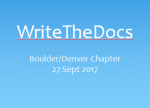Yet another study is out, this one from UC Berkeley: Most developers think we should spend more time on documentation, showing that developers, when asked, say that they want more documentation, or, in this case, need to spend more time working on (writing?) the documentation for the software they use and write. The list of related studies is long (by software-documentation-related-studies standards, anyway), a few of which I mention in A brief history of API Docs and in my bibliography.
I understand the the desire to ask developers (over and over, now) questions like “do you have enough documentation?” “what’s wrong with the documentation?” “What do you want to see more of in documentation?” and so on, when those are the questions on your mind. However, that type of question has been asked for over 15 years and the answers haven’t changed.
At this point, we should just assume that,
Developers will always tell you that they want more documentation.
They always have and they always will.
If you want to know why they express this need for more documentation, my hypothesis (based on previous research) is that it’s…
Because developers can’t find the documentation they need when they need it.
Continue reading “Do we want more docs, or just better docs?”



